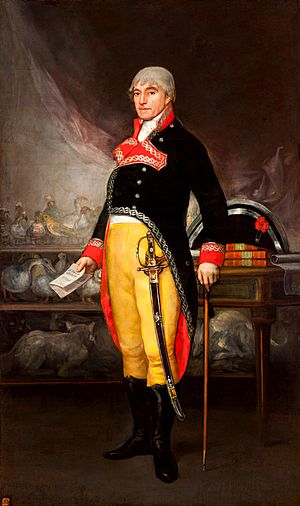Félix de Azara facts for kids
Quick facts for kids
Félix Manuel de Azara
|
|
|---|---|

Félix de Azara by Francisco Goya.
|
|
| Born | 18 May 1746 |
| Died | 20 October 1821 (aged 79) Barbuñales, Spain
|
| Nationality | Spanish |
| Occupation | Soldier, geographer, engineer |
| Known for | Description of many birds |
| Scientific career | |
| Author abbrev. (zoology) | Azara, Az. |
Félix Manuel de Azara y Perera (born May 18, 1746 – died October 20, 1821) was a Spanish military officer, a person who studied nature, and an engineer. He is famous for exploring South America and describing many new animals, especially birds.
Contents
Félix de Azara's Life
Félix de Azara was born in a town called Barbunales in Aragon, Spain, on May 18, 1746. He joined the army and went to a military school in Spain. He became an engineer, which means he was good at planning and building things. He showed his skills on many trips. He spent about 13 years in the military and became a high-ranking officer, a brigadier general, in the Spanish Army.
Exploring South America
In 1777, Spain and Portugal signed an important agreement called the Treaty of San Ildefonso. This treaty was about settling a border dispute between their colonies in South America, near the Río de la Plata region. Azara was chosen to be part of the Spanish team sent to define the new border. He quickly left for the New World.
However, the Portuguese team never arrived. Azara ended up staying in the region from 1781 to 1801. To use his time well, he decided to create an accurate map of the area. During these mapping trips, Azara started observing the local nature.
Discovering New Animals
While in South America, Azara became a keen observer of wildlife. He carefully described many animals he saw. He wrote about 448 different birds. After removing duplicates (like male and female birds of the same species), he still identified 381 unique birds. About 178 of these were completely new to science.
He also found 78 types of four-legged animals, called quadrupeds. Forty-three of these were new discoveries. Many animals were later named after him to honor his work. These include the Azara's night monkey (Aotus azarae), Azara's agouti (Dasyprocta azarae), Azara's grass mouse (Akodon azarae), and Azara's spinetail (Synallaxis azarae). Even a feature on the Moon, called Dorsum Azara, is named after him.
Before leaving South America, Azara sent his notes and observations to his brother, José Nicolás de Azara. His brother was the Spanish Ambassador in Paris at the time. These notes were published in Paris in 1801 as Essai sur l'histoire naturelle des quadrupèdes du Paraguay. Another book, Apuntamientos para la Historia natural de los cuadrúpedos del Paraguay y Río de la Plata, was published in Madrid in 1802.
Return to Europe
Azara returned to Europe in 1801 and went to Paris to meet his brother. There, he published a book called Voyage dans l'Amerique meridionale depuis 1781 jusqu'en 1801 (1809). This book included his observations on many topics. It covered the geography of the region and descriptions of the many native groups living there.
After his brother passed away, Azara went back to Spain. He held several smaller government jobs. Félix de Azara died from pneumonia on October 20, 1821. He was buried in his family's burial place in the town where he was born.
Azara's Important Works
Azara's books were well-received, though some people had criticisms. He mainly wrote his works to correct what he thought were mistakes in a famous book called Histoire naturelle by Georges-Louis Leclerc, Comte de Buffon. Smart people praised Azara for how thorough and accurate his observations were.
Even Charles Darwin, the famous naturalist, thought highly of Azara's work. Darwin often mentioned Azara in his own books. He respected Azara's knowledge, even though Azara was not a professional naturalist. Darwin cited Azara's writings on weather, insects, birds, and old artifacts from the River Plate area. Darwin even owned a translated copy of Azara's book about the quadrupeds of Paraguay.
See also
 In Spanish: Félix de Azara para niños
In Spanish: Félix de Azara para niños

